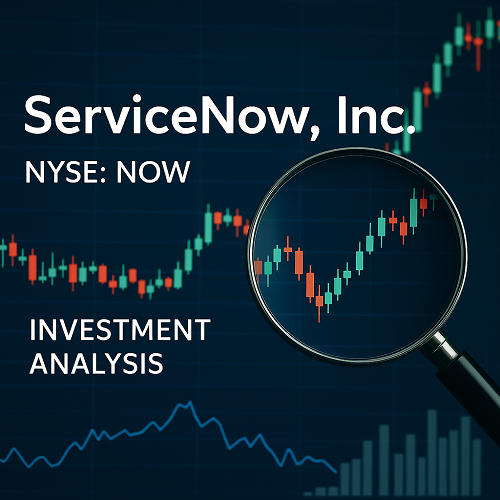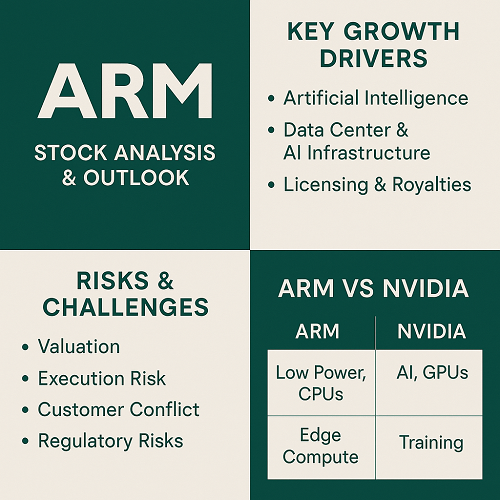ServiceNow, Inc. (NOW) stands as a leader in enterprise workflow automation, boasting a robust cloud-SaaS model and a rising footprint in artificial intelligence (AI). With a market capitalisation near $190 billion and a consensus 12-month price target of ~US$1,159 (≈ 26 % upside from current ~US$918) , NOW offers a compelling mix of growth and premium valuation. That said, the elevated P/E (over 110x) and execution risks (especially around AI monetisation) warrant careful consideration.
This article presents a deep dive into ServiceNow’s business model and history, growth drivers (including AI), financial performance & valuation, competitive position, catalysts and risks, and a near-term outlook—intended to provide both traders and longer-term investors with a high-quality resource that could outrank simpler summary pieces.
Company Overview & Business Model
Company Snapshot
- Headquartered in Santa Clara, California, ServiceNow was originally founded in 2003 (as Glidesoft) by Fred Luddy and later renamed to Service-Now.com in 2006.
- The company went public in 2012 and is now a constituent of the S&P 500.
- It employs ~26,000+ employees globally (2024) with a broad SaaS business model.
Business Model
ServiceNow’s core proposition: an enterprise-grade cloud platform that brings together “any AI, any data, any workflow” to automate business processes across IT, HR, customer service, security, and more.
Key business lines include:
- IT Workflows: IT service management (ITSM), IT operations management (ITOM), IT asset management.
- Employee / HR Workflows: HR service delivery, workplace services.
- Customer Workflows: Customer service management, field service management.
- Security & GRC: Security ops, governance/risk/compliance.
- Creator / Platform: Low-code application development, integrations, bespoke workflow building.
Revenue is subscription-based (recurring) plus professional services. By building large customers and deep engagements (e.g., customers generating > US$20 m ACV) the business exhibits high switching costs and expansion opportunities.
Recent Strategic Focus
- Heavy push into AI: The “Now Platform” is being enhanced with generative AI and agentic AI capabilities to automate increasingly complex workflows and decision-making.
- M&A activity: To accelerate capabilities, ServiceNow acquired AI start-ups (e.g., Moveworks) to bolster its agentic AI roadmap.
- Geographic and vertical expansion: Beyond IT departments, ServiceNow is moving “front-office” with CRM/field services, and expanding internationally.
Growth Drivers & Strategic Advantages
- Recurring Subscription Revenue Model – The SaaS model ensures high visibility on future revenues, strong retention, and upsell potential.
- Large Enterprise Customer Base & Expanding ACV – As customers adopt more modules, the wallet share for ServiceNow increases.
- High Switching Costs / Platform Stickiness – Workflows become embedded in operations; migrating to another system is disruptive.
- AI + Automation Tailwind – With enterprises focused on operational efficiency and digital transformation, ServiceNow’s offering is well-positioned. For example, its “Now Assist” gen-AI suite aims for US$1 billion in ACV by end 2026 per disclosures.
- Ecosystem & Partner Network – Consulting partners, systems integrators, and ISVs build on the Now Platform, which further entrenches ServiceNow’s position.
Financial Performance & Metrics
Recent Results
- Q3 CY2025: Revenue rose 21.8% y/y to US$3.41 billion (subscription growth strong) per Yahoo Finance.
- Analysts estimate EPS and revenue growth continue mid-to-high double digits.
- Key valuation metrics: P/E over 110x, PEG ~4.1, P/B ~19.7 suggesting a premium valuation.
Valuation Considerations
- Consensus 12-month price target ~US$1,159.66 (≈ 26% upside) based on ~37 analyst ratings.
- While the growth story is intact, the elevated valuation means investor expectations are high, and any mis-step could lead to multiple contraction.
- Compared to peers, ServiceNow trades at a premium; hence margin expansion, cross-sell/upsell execution, and AI monetisation will be key to justify the premium.
Competitive Position & Market Landscape
Competitive Landscape
ServiceNow competes (directly or indirectly) with major enterprise software players such as:
- Salesforce, Inc. (CRM & workflow)
- Microsoft Corporation (Dynamics + Power Platform)
- Oracle Corporation (ERP/cloud + automation)
- Niche/vertical workflow automation specialists
Despite this crowded field, ServiceNow’s distinct advantage lies in its platform-agnostic workflow engine, strong enterprise adoption, and deep integration across IT/HR/customer-service functions.
Moat & Strengths
- Broad module portfolio spanning entire enterprise workflows
- High enterprise criticality: Once workflows are built, switching is expensive
- Strong brand and ecosystem of partners + large customer base
- Momentum in AI – a future growth frontier
Weaknesses / Threats
- As the platform expands into front-office/CRM, it enters more crowded markets where entrenched competitors hold strong positions
- Monetising newer AI and workflow modules will require convincing customers of ROI in near term
- Valuation sensitivity: Premium valuations mean execution must consistently deliver
Catalysts & Risks
Catalysts
- AI Monetisation: The ramp-up of “Now Assist” and agentic AI modules could unlock significant incremental revenue. Projected US$1 billion ACV by end-2026.
- Cross-Sell & Upsell: Expansion within existing customers into multiple suites and verticals.
- International Expansion: Growth opportunities in Europe, APAC and other regions.
- Platform Adoption: Migration of legacy on-prem workflows to cloud; shift in global enterprise IT budgets towards automation and SaaS.
- Margin Expansion: As scale increases and subscription mix rises, profitability could accelerate.
Risks
- Valuation Risk: With P/E >100x, any slowdown in growth or sentiment could trigger a sharp re-rating.
- Execution Risk: Failure to monetize AI modules or delays in product rollout could disappoint.
- Competition & Disruption: Large tech vendors may bundle workflow/AI capabilities aggressively, pressuring ServiceNow’s market share or pricing.
- Customer Concentration / Macro Risk: Enterprise spending cycles can be volatile; recession risk could slow large deals.
- Acquisition Integration Risk: M&A strategy (e.g., AI pre-start-up buys) brings execution and culture integration risks. Incidentally, a large acquisition was noted earlier.
Outlook & Valuation Framework
2025–2026 Outlook
- Assuming ~20–25 % annual revenue growth over next 2–3 years, consistent with recent trends.
- Margin expansion from increased subscription/AI mix could improve operating leverage.
- If AI modules ramp as projected (e.g., US$1 billion ACV by 2026), this could be an incremental booster above base case.
- Using the current consensus target (~US$1,159) reflects these assumptions, but leaves less margin for error given the high starting valuation.
Valuation Scenarios
- Base Case: ~23% growth, moderate AI adoption → target ~US$1,100–1,200.
- Bull Case: >25% growth + AI ramps ahead of schedule → >US$1,300+.
- Bear Case: Growth slows to <20% and AI monetisation delays → multiple contraction (e.g., P/E drops from 110x to ~70x) → share price could fall materially.
Thus, price action will depend heavily on the forward guidance, execution around AI, and margin expansion.
Investment Thesis: Why Buy / Why Wait
Why Buy NOW
- Leading player in workflow automation, with broad enterprise SaaS exposure.
- Strong growth prospects tied to AI + digital transformation tailwinds.
- High switching cost and expanding customer relationships suggest solid long-term retention and expansion potential.
- Analysts are moderately bullish with ~26% upside.
Why Wait / Caution
- The current valuation is steep, leaving little room for disappointment.
- Monetisation of newer offerings (AI agents, front-office workflows) remains nascent — results will need to prove out.
- Macro risks (enterprise IT spend, economic downturn) could impact large deals.
- Competitive intensity is increasing — being a great company isn’t a guarantee of easy growth.
Key Metrics & What to Watch
- Annual Recurring Revenue (ARR) / ACV growth: especially from large customers (>US$20 m revenue).
- Subscription vs Services mix: Higher subscription mix = more predictable, scalable revenue.
- Gross margin & operating margin expansion: Ability to lever fixed costs.
- AI module adoption: Growth of “Now Assist” and other agentic AI suites.
- Guidance for next quarters: Particularly FY 2026 outlook, which is referenced in disclosures.
- Valuation multiple changes: Particularly if P/E compresses/expands with growth.
Conclusion
ServiceNow is a high-quality business positioned at the convergence of workflow automation, cloud SaaS, and artificial intelligence. For a seasoned trader or strategic investor, NOW presents a strong growth narrative—provided execution remains smooth and market expectations are met or exceeded. The reward potential (~25-+ % upside) is attractive, but the risk of valuation compression is non-trivial given the elevated multiples.
From a practical standpoint: if you believe in the long-term shift toward enterprise automation and AI, ServiceNow may warrant a core position. If you’re more cautious (valuation-sensitive or focused on near-term returns), you may choose to wait for a relative pull-back or clearer AI monetisation proof.





 XAUT-USD
XAUT-USD  AMD
AMD  MARA
MARA  SHOP
SHOP  BULL
BULL  CL=F
CL=F